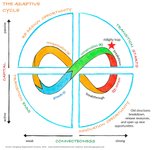
The adaptive cycle as a dynamic map for resilience thinking

One of the major lessons we learn from the unique complexity of life is the following: the only thing we can always expect when manipulating the living world is that there will be unexpected consequences. By definition, those consequences are rarely aligned with the initial goal of our intervention. Climate change, biodiversity loss, and our... See more
Understanding Living Systems
Understanding Living Systems
johannesjaeger.eu
This region of the dynamic spectrum, where outdated order dissolves into a creative and responsive chaos from which novel order can emerge, is often referred to as “the edge of chaos.” Stuart Kaufman suggested: “The best place for a system to be, in order to respond appropriately to a constantly changing world, is at the edge of chaos.” He
... See more